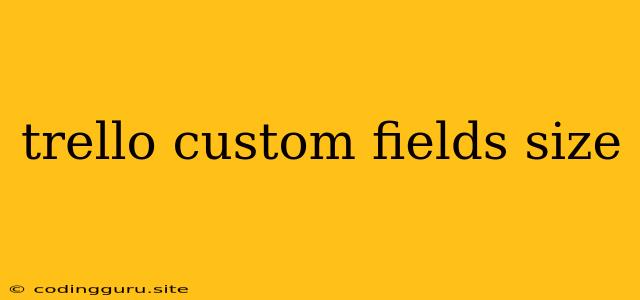Trello Custom Fields: Mastering Size and Beyond
Trello, the popular project management platform, offers a great degree of customization with its custom fields. These fields allow you to capture specific information related to your tasks, cards, and projects, going beyond the standard title, description, and due date. But what about controlling the size of these custom fields? How can you optimize the display of your custom fields for clarity and efficiency?
Understanding Custom Field Size
Custom fields in Trello, by default, have a predefined size. While this is convenient for quick data input, it may not always be ideal for capturing detailed information or for aligning the layout of your board.
Trello doesn't offer a direct setting to control the size of individual custom fields. This means the default size is the only option provided. However, there are still some ways to manage the appearance and space occupied by your custom fields.
Tips for Managing Custom Field Size
-
Choose the Right Field Type: Trello offers various field types, each with different display characteristics. For example, a text field will generally occupy more space than a checkbox field. Consider the type of information you need to capture and select the field type that best suits your needs.
-
Use Dropdown Fields: If you have limited options for a particular field, using a dropdown field can save space. Instead of requiring users to type in data, dropdowns provide a pre-defined list of choices, keeping the field compact.
-
Optimize Field Labels: The label of your custom field directly influences its visibility and space requirement. Keep labels concise and descriptive, avoiding unnecessary words or phrases.
-
Think About Card Layout: While you cannot directly control the size of individual custom fields, you can adjust the overall card layout in Trello. This can have an indirect impact on the perceived size of the custom fields within the card.
-
Experiment with Board Design: Trello offers flexibility in board design. Consider experimenting with different card layouts and arranging your custom fields within each card to optimize visibility and space usage.
Beyond Size: Custom Fields and Their Impact
While custom fields in Trello don't have a direct "size" setting, their effectiveness lies in their ability to structure your workflow and information.
How can you leverage custom fields effectively?
- Track Key Information: Custom fields can capture essential data points that might not be captured through standard Trello fields. This data can be crucial for analysis, reporting, and making informed decisions.
- Create Filtering and Search Opportunities: When you add custom fields to your board, you gain the ability to filter and search based on the information they contain. This can streamline your workflow and help you quickly locate specific cards.
- Enhance Team Collaboration: By utilizing custom fields to collect relevant data, you can improve communication and understanding among your team members.
Example:
Imagine you are managing a product development team. You can create a custom field called "Priority" to categorize tasks based on their urgency. By assigning a priority level to each task, you can easily filter your board to view high-priority items, improving team focus and resource allocation.
Conclusion
Custom fields are powerful tools in Trello, enabling you to tailor your workflow and capture vital information. While direct control over the size of individual fields might be limited, you can still effectively manage their appearance and optimize their impact. Remember to choose the right field types, use concise labels, and experiment with board design to create a clear and efficient user experience. By leveraging custom fields effectively, you can streamline your project management processes and achieve greater productivity with Trello.
